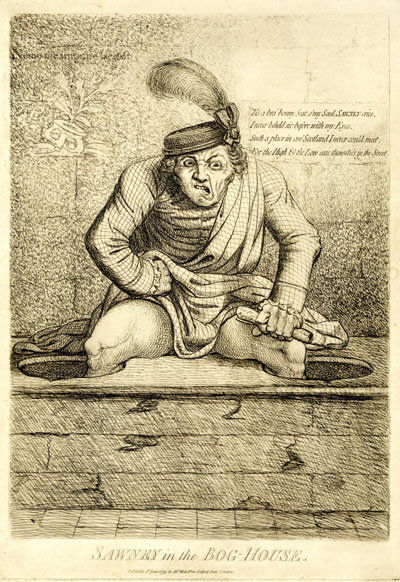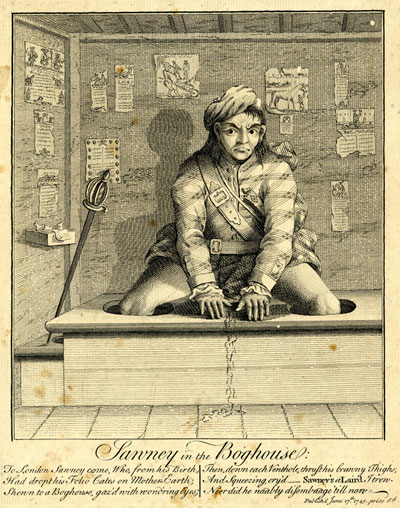Sawney in the Bog-House
Usually attributed to Gillray and included among the 45 "Suppressed Plates" in the Bohn Edition of The Works of James Gillray, Sawney in the Bog-House is one of several identically titled and variously crude satires from as early as 1745 on the backwardness of Scotsmen (Sawney) in general, and the ignorance of this particular Scotsman trying to use an English outhouse (bog-house).

© Trustees of the British Museum
Dressed in a traditional tartan with a Balmoral cap and feather, Sawney sits on the bench of the outhouse with his legs in the holes where his posterior should be. On the wall over his right shoulder there is a faint image of a thistle plant growing out of an inverted crown. Above it is a Latin motto "Nemo me impune lacessit" (No one provokes me with impunity). The thistle is the national plant of Scotland; the Latin expression is the motto of both the royal Stuart dynasty, and the Scottish heraldic Order of the Thistle.
Sawney's contorted expression and clenched hands are open to several interpretations. They may be simply an illustration of that Scottish prickliness described in the motto. Or they may suggest anger with the recently passed Papists Act of 1778 (aka the Catholic Relief Act of 1778) which upset Scots like Lord George Gordon who regarded any concessions to Catholics as tantamount to establishing papal rule in England.* (The scroll in Sawney's hand is inscribed "Act for [esta]blishing Popery.") Or it may be the uncomfortable and malodorous result of his ill-chosen position. The ironic rhyming couplets next to him, however, help to explain his mistake.
'Tis a bra' bonny seat, o' my saul, Sawney cries,
I never beheld sic before with me Eyes,
Such a place in aw' Scotland I never could meet,
For the High and the Low ease themselves in the Street."
Like Dr. Johnson's celebrated definition of oats as "a grain, which in England is generally given to horses, but in Scotland supports the people," English humor liked to portray Scots and Scotland as backward and uncivilized, unacquainted with modern conveniences. So it is not surprising that Gillray's Sawney is based on an even cruder predecessor.

© Trustees of the British Museum
In this version (sometimes misattributed to Hogarth) published by Charles Mosley in the same year as the Jacobite uprising of 1745, Sawney is a soldier and the bog-house well-decorated with posters and handbills. But unlike Gillray's Sawney, this one is fatuous as well as ignorant, delighting in his lordly use of the privy while soiling himself in the process.
To London Sawney come, who, from his birth,
Had dropt his folio cates on Mother Earth;
Shewn to a boghouse, gaz'd with wondering eyes,
Then, down each venthole, thrust his brawny thighs;
And squeezing cry'd "Sawney's a laird. I trow",
Neer did he naably disembaage 'till now.
* Mark Jenner in "Sawney's Seat, the social imaginary of the London bog-house c.1660-c.1800" identifies Sawney as, in fact, a portrait of Lord George Gordon.
Sources and Reading
- Commentary from the British Museum on Gillray'sSawney in the Bog-House.
- Draper Hill, Fashionable Contrasts, 1966, #76
- "Sawney," Wikipedia
- "Order of the Thistle," Wikipedia
- "Papists Act 1778," Wikipedia
Comments & Corrections
NOTE: Comments and/or corrections are always appreciated. To make that easier, I have included a form below that you can use. I promise never to share any of the info provided without your express permission.